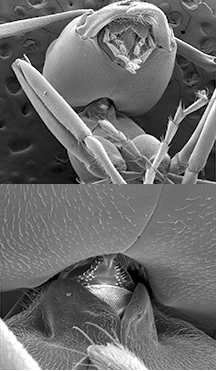Tests to lift necks from Nature's toolbox
 Researchers are looking to nature for design advice, looking to pinch the secrets of their astounding neck joints.
Researchers are looking to nature for design advice, looking to pinch the secrets of their astounding neck joints.
The neck joint of a common ant can withstand pressures up to 5,000 times the ant’s weight – now, engineers are studying whether similar joints might enable future robots to mimic the weight-lifting ability on earth or in space.
“Before we started, we made a somewhat conservative estimate that they might withstand 1,000 times their weight, and it turned out to be much more,” says Carlos Castro, assistant professor of mechanical and aerospace engineering at The Ohio State University.
Tragically, some ants must lose their lives for the engineers to steal their secrets, but there are very few more willing team-players in the natural world than workers in an ant colony.
“As you would in any engineering system, if you want to understand how something works, you take it apart,” Carlos said.
“That may sound kind of cruel in this case, but we did anesthetise them first.”
The engineers examined the Allegheny mound ant (Formica exsectoides) as if it were a device they wanted to reverse-engineer; testing its moving parts and biological materials. The ant is an average field ant, not particularly known for its lifting ability.
In a mildly macabre experiment to test the ants’ neck strength; their heads were glued to a specially-designed centrifuge. It was spun to exert increasing outward force on the joint.
At forces corresponding to 350 times the ants’ body weight, the neck joint began to stretch and the body lengthened. The ants’ necks ruptured at forces of 3,400-5,000 times their average body weight.
Micro-CT scan investigation showed a number of interesting design details that come together to lend the insect is incredible strength.
Electron microscopy images revealed that each part of the head-neck-chest joint was covered in a different texture, with structures that looked like bumps or hairs extending from different locations.
The transitions between soft material of the neck and the hard material of the head should create large stress concentrations, but ants have a graded and gradual transition between materials that gives enhanced performance - which could prove useful in man-made designs.
“Now that we understand the limits of what this particular ant can withstand and how it behaves mechanically when it’s carrying a load, we want to understand how it moves. How does it hold its head? What changes when the ant carries loads in different directions?” Castro asks.
“One day, this research could lead to micro-sized robots that combine soft and hard parts, as the ant’s body does. Much work in robotics today involves assembling small, autonomous devices that can work together,” he said.
Essentially, ants are strong because their self-supporting exoskeletons allow internal muscles to be dedicated solely to lifting. Humans are weak by comparison, as our internal skeletons require constant muscular support, limiting lifting resources.
More details on the recent tests are available in the full report, accessible here.








 Print
Print